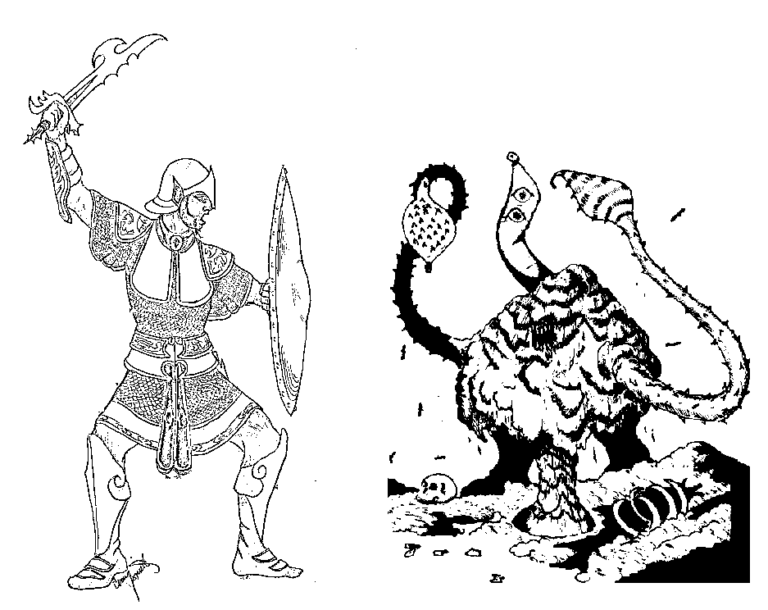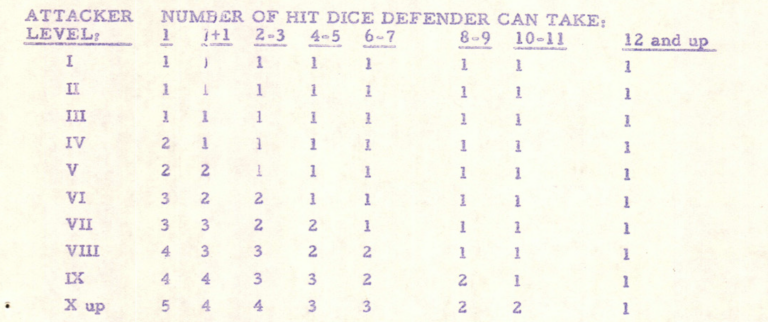
The range of combat additions made in the “mimeo” Empire of the Petal Throne is fairly remarkable, given that it was written in March and April 1974, just after OD&D was released. [NB: all section references in this blog post are to the sections as listed in the mimeo EPT.]
A summary of the combat additions made in the mimeo EPT would include the following:
- Weapon skill as a character ability
- Experience awards
- Hit dice determination
- Variable hit dice depending on character species
- Dying blows
- Damage enhancement for powerful characters
- Critical Hits
- Morale in Combat
- Mass Combat
Weapon Skill: In Sec. 430, characters who choose the warrior profession develop proficiency in various kinds of weapons and martial skills. It also seems to suggest that a character cannot actually use a weapon until getting trained in it, which is probably an artifact of when EPT was written. “A warrior who initially shook only 17 would thus have to wait until he reached third level before he could use a sword.” This is almost certainly a legacy of wargaming rules, where troop type differentiation was important.
In Sec. 431, we read “The skills used by fighting men are mostly self-evident” followed by brief explanations of military activity skills, e.g. strategist. This is true in a general sense, but there is no explanation of the benefits accrued, aside from the enabled usage of a weapon. These days, I prefer James Maliszewski’s house rule that, while anyone can pick up a weapon and attempt to use it, having skill in a particular weapon provides a +1 to damage (not to hit!).
Experience Awards: In Sec. 440, it is noted that
“An enemy incapacitated (paralysed, etc.) by one player and then slain by some other player gives NO credit to either player! No player may normally slay a being incapacitated by another player, although such a situation might occasionally arise and be allowed by the referee: e.g. a magic user manages to ‘freeze’ a creature with an Eye, but is then paralysed by the creature’s sting himself as it takes its dying blow. If no means of releasing the magic user from paralysis is found, then another player may indeed slay the creature — with neither player getting any experience point credit. Otherwise, experience points for slaying hostile beings go to the ACTUAL KILLER, in spite of others who may have participated in the victory.”
This rule may very well have been put into place for two reasons: (1) Prof. Barker had already encountered various arguments about experience awards while playing OD&D and wanted to settle various issues as he saw them, and (2) he wanted to emphasize the idea that player characters should be heroic, and strive to act that way. [The consideration of experience points in EPT deserve its own blog post.]
Hit Dice and Damage Taken: another place where the text in the mimeo EPT appears to be written to answer ambiguities in OD&D. The first concerns when a character is considered dead. This is left unclear in OD&D, but the implication is that when a character reaches zero hit points, they should be treated as dead. In the mimeo EPT, however,
“Whenever [a character] is wounded, he subtracts the number shown by his opponent’s damage dice from his hit points until he is either at zero (Incapacitated: cannot fight and must be carried, though still alive), or until the damage exceeds his hit dice total, in which case he is dead.” (Sec. 510)
While this might seem to be a relatively minor difference, it is significant from a play perspective. Similar ideas begin to appear in Advanced Dungeons & Dragons, but that would be three years in the future after the initial release of EPT.
Hit point progression: The other difference had to do with rolling at higher levels for hit points. OD&D, again, is unclear about how to determine accumulated hit points as characters progress in levels. When a character gains a hit die, is that rolled and then added to the previous total? Or are all of the character’s hit dice rolled anew at each new level? EPT comes down clearly on the latter method of hit point determination:
“No character may ever have LESS hit points at a higher level than he did at a lower one. Thus, if a warrior shook two 5’s and had 10 hit points at Level II, and then on attaining the 3rd Level shook three dice but obtained only a total of 7, he must add 3 points to bring his total up to his previous 10. He must thus always equal his previous hit points total, though he may not be lucky enough to exceed it.” (Sec. 510)
It is worth noting that Empire of the Petal Throne even at this early stage was focusing more on individual characters than the combat system(s) in Original D&D, which makes sense as a move away from the abstraction of the Chainmail combat system.
Different hit dice based on character species: In addition to hit point determination, in Section 510 the mimeo EPT introduced different amounts of hit dice, depending on the race (really species) of the character and their profession. Humans are assumed to have a base of one hit die at first level.
“Creatures which follow the same hit dice system as men do are: Páchi Léi, Pé Chói, Swamp Folk, Pygmy Folk, and Tinalíya….Basic 2-dice creatures area are: Hláka, Hlutrgú, Hlýss, Shunned Ones, and the Ssú….Basic 3-dice creatures include the Shén and the Ahoggyá.” (Sec. 510)
This raises the interesting possibility of doing something similar in D&D, which also emerged much later in the D&D 3.0 book, Savage Species.
Damage enhancement for powerful characters: mimeo EPT assumes that all weapons do one six-sided die of damage, just like in OD&D: “All attacks which score hits do 1–6 points damage unless otherwise noted.” (OD&D Book I, Men & Magic) But rather than making a differentiation between “man-like types” and stronger monsters for the number of blows, mimeo EPT provides for more damage to be done, as characters gain levels:
“It is assumed that any blow which “hits” (cf. preceding Section) does some damage. The amount of such damage depends partially upon the character’s Experience Level. This represents increases in his prowess and combat ability. If a character hits, he does the following number of 6-sided dice of damage according to his level…”

The explanation following the chart notes that damage carries across multiple opponents, potentially resulting in several lower-level casualties. This a different solution than the one provided in the second issue of The Strategic Review, coming out over a year later in the summer of 1975. There is also a distinction made between different professions:
“Priests and magic users do less damage dice injury than do warriors. If the attacker is a priest, move the damage dice level UP one horizontal line: e.g. a 3rd Level Priest has the same damage as a 2nd Level fighting man. Magic users are only permitted the use of one or more daggers; they may use no other ordinary weapons. If a magic user hits with his dagger, move his damage dice UP two horizontal lines: e.g. a 9th Level magic user does the same hit dice damage as a 7th Level fighter.” (Sec. 530)
Critical Hits: The mimeo EPT is also notable for having the first critical hit system for a TTRPG:
“If a player hits with a 20-sided die score of 20 (cf. Sec. 520 above), he does DOUBLE hit dice damage. A 4th Level fighter will then do FOUR dice damage against one-die creatures.” (Sec. 530)
This is a simple addition which would be completely acceptable in OD&D.
Morale: the mimeo EPT also provides rules for morale, clearly inspired by similar rules in Chainmail, as OD&D does not have specifically stated morale rules. The section in the mimeo EPT follows the system provided in Chainmail:
“Unless specifically mentioned in the list of descriptions of beings (cf. below), a ‘morale check’ must be made whenever the number of remaining fighters in a melee falls below a certain percentage of their total number.” (Sec. 540)
It is not exactly clear when a morale check is to be made – the rule is “whenever the number of remaining fighters in a melee falls below a certain percentage of their total number” which suggests immediately after the end of a combat round.
Dying Blows: the question of whether or not a character might get a dying blow was left unanswered in OD&D. Not too surprisingly, Prof. Barker answered this question by noting that warriors (and monsters?) always get a “dying blow”:
“A fighter always gets a chance to strike on any combat round in which he is involved. Thus, even if he is slain on that round, he has a chance to take a ‘dying blow’ as he dies.” (Sec. 550)
This does imply that priests and magic-users might not get a dying blow. This would be fitting, given their restrictions on use of weapons and armor.
Mass Combat: It was not lost on Prof. Barker that players of the mimeo EPT might not have access to Chainmail or other miniatures rules. Accordingly, he provided rules for larger combats, once players considered the possibility of hiring significant numbers of troops:
“Obviously, it will become necessary occasionally to split up larger groups of men and beings for combat purposes. e.g. ten player characters and a hundred hired troops encounter 300 bandits! To roll hit dice, etc. for each man would take far too long. Nonplayer characters may thus be grouped into sets of five or ten or even larger, if desired, and ‘fought’ as one man.” (Sec. 550)
In essence, this is something of a “re-abstraction” of OD&D combat, which gets expanded further in the published “TSR” EPT. But the idea of facing off against a larger number of enemies in “wilderness” areas is likely a carry-over from OD&D, where such numbers are seen in the “Number Appearing” column of monsters.
It is also worth observing that the example provided – 10 adventurers and 100 hired troops facing 300 bandits – ends up being something of an oddity in Tekumel as it developed over time. Three hundred bandits is nearly the size of a cohort of a Tsolyani legion (400 soldiers), which would result in an Imperial response to crush anything looking close to a rebellion, rather than some sort of “random” encounter.
Lastly, in “Dispatches to the Petal Throne” we find out later that some of the player characters in the original campaign became military officers commanding cohorts of troops. In turn, this became the basis for Qadarni (“Little war”) battles between troops of different nationalities. These Qadarni battles provided valuable fighting experience for soldiers, testing the mettle of troops and their leadership. It is unfortunate that no subsequent set of miniatures rules for Tekumel actually went into this in any great detail.
These nine additions to the basic combat system of the mimeo EPT are all worth greater consideration. They demonstrate how it was possible from the very beginning to build on this OD&D combat system, and to do this in innovative ways. It would have been quite easy to take all of these additions and “retro-fit” them onto any OD&D campaign. This illustrates how Empire of the Petal Throne can and should be viewed as an unrecognized and underappreciated supplement for OD&D.
Next Time: I look at the combat additions made in the published or “TSR” EPT, and how they reflect some issues which must have arisen during the course of play in the original campaign.

Nice to read about the dying blow. I always liked that rule except for monsters. I think my father also came up with it independently.